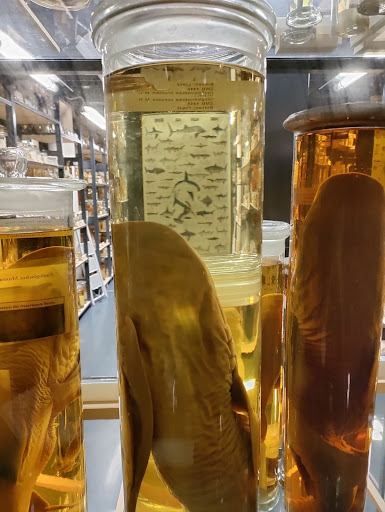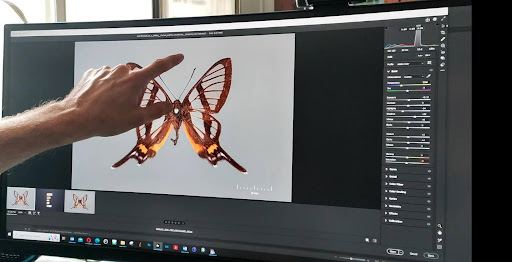The stuff of taxonomic nightmares: the frustrating volatility of color
Roos Hopman
05/23/2025 | Reflections
Color matters in natural history. It matters because the color of a specimen (whether it’s a butterfly on a pin, a dried plant, worms in a jar, or a mounted bird), can be used to help identify and classify it, to determine which species it belongs to. This work of species identification is taxonomic work: work of determining what is what, of putting things in their place. Taxonomy is also one of the main organizing principles of biology and natural history, and central to the functioning of the natural history museum as an institution. This is not only to ensure all is in order: if the colors of a specimen correspond to the colors of a living animal or plant of that species, it can then be used in biological analyses and comparisons, adding to the specimen’s research value. Because of its potential for identification, and its role in research, color is a characteristic that is deemed valuable to maintain - to conserve - in a specimen.

Figure 1. Fish preserved in alcohol, public exhibition at the Museum für Naturkunde Berlin. [Image credit: Roos Hopman]
A changeable thing
Color is valuable in natural history, but it is not easy to capture or contain; it easily slips through our fingers. For instance, when an organism dies, i.e. when it is killed to be collected, its pigments deteriorate. Greens and pinks may turn to browns. This presents a paradox and a problem for institutions that have been built around collections of millions of dead creatures, most of which are stored in depots. Killing is necessary to collecting, yet it obviously results in a loss of liveliness, leading to a loss or change of color.
Apart from the killing of an organism itself, practices of collecting and conserving an animal or plant may additionally alter their colors. Historically, insects were sometimes temporarily stored in cigar boxes after collection in the field. The color of the box affected the color of the specimen. Conservation methods to slow the decay of a dead organism, such as spraying a specimen with chemicals, or the preservation method of “pickling” an animal in liquids such as alcohol or formalin, resulted in more color changes. Not to mention the issues of exhibition and storing collections: exposure to UV light may affect the color of feathers and furs, or fade the colors of certain minerals. As the Spanish naturalist Félix de Azara (1742-1821) commenting on practices of killing and collecting animals in natural history collections, had it: “the injury of time must have altered the colors heavily, changing the black into brown, etc.” (1802: v2, i-ii)”.
Color is, in short, a slippery and highly changeable thing. This was already recognized by Carl Linnaeus (1707-1778), one of the first taxonomists, who excluded color as one of characteristics that could be used for the identification of species altogether. “Colour is remarkably changeable, and so is of no value in definitions”, he wrote in his Philosophia Bontanica (1751: 229). Not only was he concerned about the changeability of the colors of organisms in nature, but also because reproducing their colors in scientific illustrations was an impossible task at the time. Not only were the materials (natural pigments derived from e.g. dried insects or even arsenic) needed to mix colors expensive and hard to come by, but recreating the exact same mix of materials was unworkable without the availability of precise “colour recipes” (Nickelsen 2006). Reproduction, in the form of producing water colors or colored drawings of specimens, was however important to recording and spreading the orders and taxonomic classifications of the natural world. These illustrations provided a resource for the identification of already recorded species, and allowed for the recognition of potential new ones. The efforts made at maintaining and representing colors “correctly” in other words point us towards the issues of impermanence, of containment, and of reproduction.
Figure 2. Digital image of a butterfly specimen[Image credit: Roos Hopman]
From watercolors to color balance
Current efforts at natural history museums worldwide to digitize their entire collections of specimens may be seen as a continuation of these practices of - and struggles with - reproduction. And in these digitization projects, color arises as an issue once again. In the effort of generating data from specimens, including (but not limited to) the taking photographs of specimens and the transcribing of the data of labels attached to them, we see that something interesting happens. Working not with watercolors but with digital images of specimens, for example pinned butterflies, photographers stressed that an important part of their tasks is “color correcting” images. Or, as a particular photographer at the Museum für Naturkunde Berlin (hereafter: MfN) put it, “bringing out” the “true colors” of a specimen. In practice, the specimen itself did not need to be physically present for this correcting work. Nor was any comparison with a live organism necessary. The butterfly itself, the reference perhaps, ceased to matter altogether. Bringing out the true colors in digitization work became a technical process of balancing the reds, blues, and greens of an image of the specimen with photo editing software. What provides the reference for the correct (meaning, consistent) balance of colors is then not the specimen or the image of the specimen itself, but its background: a measured mix of white and black known as “gray card”. With its consistent mixture of white and black, gray card functions as the reference against which the colors of an image can be calibrated. “When you use this gray card”, this photographer told me, “you can be sure that the colors are correctly calibrated and that we are creating images with the right colors.”
Again, after the colors of the images have been corrected and stored onto a drive or in a cloud, leakage loomed on the horizon. I was told by one of the photographers at the MfN that all computer screens “lose color” over time, and that they need to be calibrated yearly to display colors “correctly”. And that different internet browsers, such as Chrome or Firefox, in addition display colors differently. It is for good reason that this particular photographer remarked that “colors and specimens are a f-ing nightmare.”
Making life and death visible
Color is the stuff of nightmares. Or rather: it becomes so when scientists and photographers try to contain and reproduce it. It leaks away into “fixatives” such as formalin, our pencils, our pixels. Taxonomy looks for constants. Yet the issue of color in digitization practices and natural history more broadly demonstrates the inevitability of impermanence, the leakiness of containment, and the painstaking work and uncertainty that is necessary to reproduction.
Providing the “correct” colors for specimen images is important, so the photographer I interviewed told me, because it can assist scientists in correctly identifying a specimen they may have come across during their research. Yet color may also come to serve another purpose. Bringing a specimen “to life” on a screen, as it were, it also may contribute to drawing attention to species becoming extinct. Indeed, high-resolution (and especially brightly colored!) images are used to mobilize audiences for the preservation of nature. Take for example the website “Extinct and Endangered: Insects in Peril”. There, high-resolution, colorful images of insects are used to draw attention to the decline of populations and the loss of biodiversity. Such images would not be possible to be produced on a mass-scale, such as for a whole natural history collection, as high-resolution images take up incredible amounts of server space (and so are highly expensive and environment unfriendly to maintain). Without color, these images would not have the same effect: they would not instill the same sense of loss the creators are after. As the photographer who took these images puts it in the video supplied on the website: “to marvel at its [the insects’] beauty, but then you understand also that it’s extinct. It’s gone. It’s never coming back.”
Although the website (and exhibition at the American Museum of Natural History) raise awareness of the dying of creatures, they do not demonstrate the precise processes and actors that make them die. To put it another way: the focus is reverted to the species that are threatened, not to the (historically situated) forces and people threatening them (Parreñas 2018: 12). This can be starkly illustrated by comparing Fig 2., an image taken in the collections of the MfN, to any image on the Extinct and Endangered website. Looking at the high-resolution images closely, you will note that the object reminding us that this insect is dead, that it has been purposefully killed and pinned on a metal stick, has been carefully edited out. In collection images such as Fig 2., destined for biodiversity databases, the pin remains. Having been edited so, the images on the website thus consciously direct attention towards particular kinds of death and dying, and not others. Obscured from view is the institutional violence of the natural history museum itself.
Roos Hopman is a researcher interested in the politics and practices of (genetic) biological diversity. This has brought her to study forensic genetic practices in laboratories in the Netherlands, to biodiversity data production work in the Berlin natural history museum, and now towards conservation practices in European zoos. This piece is based on her postdoctoral research at the Museum für Naturkunde Berlin as part of the BUA-funded Museums and Society: Mapping the Social project.
Published: 05/22/2025
